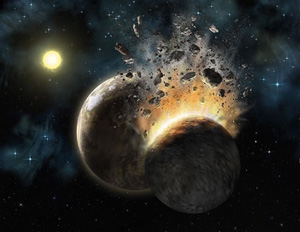Planets Collide! Not Just In The Movies Anymore
November 15, 2007 - 6:15 am - Posted by iDunzo
The early days of planetary solar systems can be violent times indeed. Our own moon was most likely birthed from a stupendous collision, before our own solar system had settled down into the relatively placid routine we see today.
Astronomers have been observing a star system called HD 23514 in the Pleiades cluster that seems to be going through the same bumper-cars evolution as our own, with rocky planets potentially similar to Mercury, Venus, Earth and Mars in the process of formation.

Using an infrared camera with the Gemini North Telescope in Hawaii, a UCLA-led team has found hot dust surrounding a star much like our own Sun, but about 45 times younger.
The warm dust appears to indicate what they call “catastrophic collisions” in a region roughly comparable to the space between the orbits of Mercury and Mars in our own solar system.
They believe that so-called planetary embryos – rocky bodies that are evolving into full-fledged planets – must have recently bumped, breaking up or even pulverizing one another. Says Inseok Song of the Spitzer Science Center:
“In the process of creating rocky, terrestrial planets, some objects collide and grow into planets, while others shatter into dust; we are seeing that dust,” Song said.
Researchers said this was the first evidence of planet formation in the Pleiades, and further supports the notion that terrestrial planets like those in our own solar system are relatively common.
Source: Gemini Observatory
